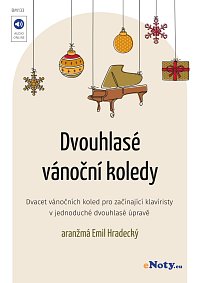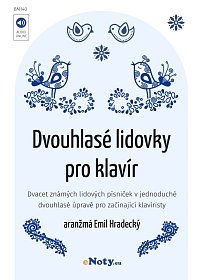Two-Part Czech Folk Songs for Easy Piano (arr. Emil Hradecky), volume 2
 Bestsellers
Bestsellers
 Recommended
Recommended
 Just purchased
Just purchased
| Publisher | eNoty.eu |
| Genre: |
music for children, pupils and students
spirituals, folk, country & traditional |
| Arrangement: |
piano
piano / chords |
| Cast: | solo |
| Difficulty: | Beginner |
| Lyrics language: | Czech |
| Format: | book + Audio Online |
Parameters
| Product code: | BM141 |
| Arranger: | Hradecký, Emil |
| No. of songs: | 18 |
| Pages: | 24 |
| Language: | Czech |
| ISMN: | 9790660650424 |
Audio examples
Songlist (20)
- Ach není tu, není
- Beskyde, beskyde
- Boleslav, boleslav
- Červený šátečku
- Já mám koně, vraný koně
- Kdybys měla, má panenko
- Když já šel tou putimskou branou
- Když jsem k vám chodíval
- Komáři se ženili
- Muzikanti, co děláte
- Nechoď tam
- Nešťastný šafářův dvoreček
- Prší, prší, len sa leje
- Rožnovské hodiny
- Šly panenky silnicí
- Tancuj, tancuj, vykrúcaj
- Tráva neroste
- U panského dvora
- Vyletěla holubička ze skály
- Žádnyj neví, co jsou domažlice
Product description
A collection of eighteen well-known Czech folk songs in easy two-part arrangements for piano. Songs for beginning pianists were arranged by the well-known Czech composer Emil Hradecký. All songs are accompanied by chords and lyrics (in Czech) and can be played not only on the piano, but also on keyboard instruments. You can also play and sing songs together and accompany the pianist on guitar, ukulele and other accompanying instruments.
The book includes a link where you can download demo recordings of the songs in the collection to give you an idea of what the songs sound like and make it easier to choose which song to learn to play first.
Emil Hradecký (*1953) is one of the most significant Czech composer, arranger and piano teacher, who is often inspired by dance music and jazz in his works. However, Emil Hradecký's work is very extensive and his "non-jazz" compositions are very melodic, pleasant to listen to and popular among teachers and their students








